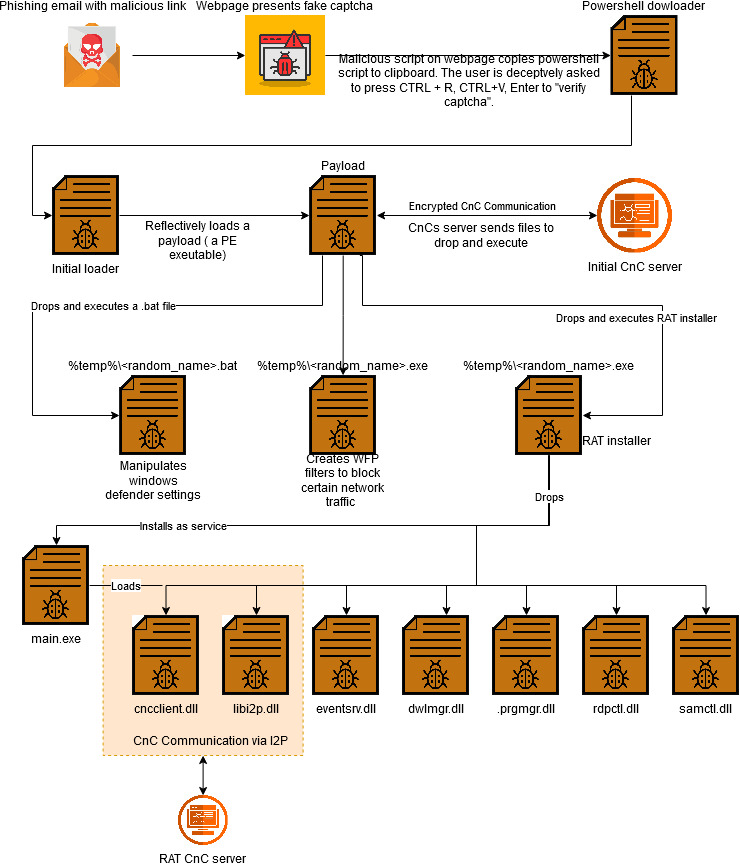On the 19th of November, X user Gi7w0rm shared information about a new type of malware that abuses I2P.
I2P for CnC communication
I2P is an encrypted peer-to-peer overlay network that enables encrypted peer- to-peer communication. An observer cannot access the content of messages, nor can they identify the source or destination. Consequently, the participants of the network transaction remain anonymous. The malware we are examining employs I2P for handling CnC communication. I2PD, an open-source C++ implementation of I2P client is used for this purpose.
The page contains JavaScript code which copies a malicious PowerShell script to the clipboard. The page urges the user to press a series of key combinations to verify as ’human’ and proceed further. If the suggestion is carried out, the user inadvertently executes the PowerShell script stored previously in the clipboard. The PowerShell script downloads the first stage malware loader and executes it. Eventually, the script opens a porn page to complete the ruse.
Initial loader
The first stage loader directly uses native APIs available from NTDLL to determine the current privileges for the process. If not running with elevated privileges, the loader employs a UAC bypass technique which is documented in the Google Project Zero blog article. The bypass leverages the RPC server exposed by the APPINFO service in windows to launch itself as an elevated process. Once running with higher privileges, the malware decrypts and reflectively loads a payload.
Reflectively loaded payload
The reflectively loaded payload is the actual malware loader and henceforth we will call it accordingly. The loader proceeds to contact a CnC server by means of a TCP socket. The communication is encrypted, though not by means of I2P yet. Initial communication is a handshake with the client sending “hello” and the server responding with “ok”. One step later, a few details like operating system version, username, under which the process is running, and if the process is running with elevated privileges are collected and sent to the CnC server. Eventually, the CnC sends a series of encrypted payloads with an instruction to execute them on the victim’s machine. Three payloads are executed in total.
Microsoft defender defense evasion
The malware employs two payloads to evade detection from Microsoft Defender. One of the payloads executed is a batch script located at %TEMP%\<random_name>.bat which invokes a series of PowerShell commands to manipulate Microsoft Defender settings. Those settings effectively revoke the consent to upload samples to Microsoft, preventing participation in Microsoft cloud-based protection (MAPS). Lastly, an exclusion to the path %HOMEDRIVE%\Users\ is set.
WFP filters to render victim machine vulnerable
Windows Filtering Platform (WFP) is a set of system services and API that enables building network filtering applications. Applications with sufficient privileges can connect to the WFP engine through the API and manage filters for network traffic. The next payload deployed by the malware to %TEMP%\<random_name>.exe, does exactly that. The malware has an embedded configuration file which determines what filters are created. Filters are created to block outbound traffic from windows update related services (WuauServ, DoSvc, UsoSvc, WaasMedicSvc). This prevents Microsoft Defender from getting security intelligence updates and platform updates leaving the system vulnerable. Filters are also created to block out applications related to Microsoft Defender (MsMpEng.exe, MsSense.exe, SenseIR.exe, SenseNdr.exe, SenseCncProxy.exe, SenseSampleUploader.exe). This would blind the Microsoft Defender ATP and EDR platforms as detection and telemetry data would not be sent to the cloud from the victim machine.
RAT installer
The loader then deploys the RAT installer to %TEMP%\<random_name>.exe and executes it. The component is around 10MB in size and has multiple components of the RAT malware embedded within it in encrypted form. On execution, the malware creates the directory C:\users\Public\Computer.{20d04fe0-3aea-1069-a2d8-08002b30309d} to store the RAT components. When a directory is created with this name, the operating system treats it akin to a shortcut to “My Computer”. Therefore, the contents of the directory cannot be examined in a straightforward manner. The trick helps to hide and make the malware files inaccessible.
Most RAT functionality is housed in DLLs shown in Figure 7. The DLLs are loaded and controlled by main.exe. The installer then installs main.exe as a system service.
The RAT components
The RAT implementation is fully modularized, and functionality is implemented in individual plugins (DLLs). Each plugin exports unit_init and unit_cleanup functions to enable starting and stopping. There are other dynamic link libraries in the directory namely libi2p.dll, termsrv32.dll and rfxvmt.dll which are not plugins themselves but are utilized by the plugins for specific purposes. Once initialized, all plugins establish a connection to the “Event Bus” to be able to receive and process events. The plugins house an event handler to process the events posted to the event bus. The events include commands that, if recognized by a plugin, will trigger the corresponding actions.
main.exe
The process runs as a Windows Service and on startup, checks if the directory from where it is run contains update packages for installation. Update packages have the name format <version>-patch.pkg. If update packages are found, the service installs them and creates a file named <version>-patch.pkg.applied to mark the package as installed. Subsequently, the malware loads all DLLs located in the executable's directory and invokes unit_init to initiate the functions of the corresponding plugins.
cnccli.dll
This plugin is responsible for initializing I2P connection and communicating with the CnC server. File “config.ini” provides configuration options for the I2P connection. For this purpose, the DLL loads libi2p.dll (I2PD) and initializes it. The plugin constantly checks for inbound communication from the CnC server and once a message is received, posts it to the event bus. The plugin itself subscribes to the event bus and can handle certain commands. Some events/commands and their respective functionality are listed below.
EventId | Action |
RCPT | Depending on event parameters
|
BCST | Forwards messages to the CnC server |
dwlmgr.dll
As the name suggests the plugin is responsible for downloading additional files. The plugin is also able to upload files when commanded.
EventId | Action |
DWLD | Downloads file and saves it to RAT directory |
DELT | Deletes file described in the event |
UPLD | Upload specified file to specified destination |
rdpctl.dll
This plugin uses a borrowed version of RDPWrapper library (termsrv32.dll) to enable RDP host support on operating systems that come with reduced functionality (like Windows Home edition).
EventId | Action |
RDP0 | Reverts actions done by RDP1 command to revert to default RDP settings |
RDPT | Collects termsrv.dll version, possibility of connection to 127.0.0.2:3389 and sends this information to the CnC server |
TICK | Repeats functionality from RDPT command. Additionally checks if the termsrv.ini (RDPWrapper config file) located at “%PROGRAMFILES%\RDP\”directory is out of date and replaces it with the one from RAT directory. Also restarts the “TermServ” service |
RDP1 | Essentially installs RDPWrapper for usage over default RDP. Copies termsrv32.dll and termsrv32.ini to“%PROGRAMFILES%\RDP\” directory. Copies rfxvmt.dll to “c:\windows\system32”directory Modifies registry to,
|
PRXO | Creates a proxy connection to route RDP traffic from attacker to victim machine and vice versa. This way the attacker can RDP to any machine inside a firewalled network |
PRXC | Closes the RDP proxy connection established previously by using PRX0 |
PRXT | Unclear |
PRXM | Unclear |
samctl.dll
A user account management plugin. The plugin can add/delete user accounts and groups as well as enumerate them. SMMG (get members), SURS (set special user account), SUSA (user add), SUSD (delete user) etc., are some of the supported commands. Since there are quite a few user-account related commands, not all are documented here.
evtsrv.dll
Event server implementation. Dispatches events received on the event bus to the subscribers. All plugins subscribe to the event server on initialization to be able to receive events and unsubscribe finally.
prgmgr.dll
Program manager plugin. The schtasks subdirectory inside the RAT directory, contains pair of similarly named .xml and .exe files where the XML file describes the task, and the executable is the task target. The malware component uses the XML files in conjunction with the “schtasks.exe” utility to create scheduled tasks. Additionally, the following functionality is housed in the plugin.
EventId | Action |
RESU | Collects and sends memory status information and network adapter information |
BRSL | Collects and sends information on installed browsers
|
PRCS | Creates specified process |
Observed scheduled tasks
Two scheduled tasks were seen to have been installed. One is an information stealer (coomgr.exe) which can, when commanded via the event bus, export stored login information from Google Chrome. The second scheduled task (sesctl.exe) supports one command, namely “SSEX”, meant to logout a particular user.
Closing remarks
Notably, the malware components create detailed log files on execution. Researching the age of this malware reveals that the malware has been active at least as early as March of 2024 and it could be older. A few cases noticed on Virustotal suggest that the malware might be distributed through PrivateLoader.
Samples used in this analysis
6f4699c909135fa5b5300aa5c8996ca8f252d1b136c1d47904135ee371f5cac6( Initial loader)
49adf0fc74600629f12adf366ecbacdff87b24e7f2c8dea532ea074690ef5f84 (Batch File)
a78945e7532ecdb29b9448a1f3eef2f45ec2f01ca070b9868258cbcd31eac23f (WFP Filter creator)
44cf4321c138c4cacecc95deba735f508c96049e7f0e8f0538684dc4f0c1e9a5 (RAT_Installer)
dab30ceacf259ea08ad512a1815447e0c9bd5e91dac70abafdc2094fa4896c98 (main.exe)
a62bdf318386aaab93f1d25144cfbdc1a1125aaad867efc4e49fe79590181ebf(cnccli.dll)
77d203e985a0bc72b7a92618487389b3a731176fdfc947b1d2ead92c8c0e766b (libi2p.dll)
adfe373f98cabf338577963dcea279103c19ff04b1742dc748b9477dc0156bb4 (evtsrv.dll)
51c131081921626d22faf44977d5e4dcfe00e5d6cddeda877a82f13631be7c2e (dwlmgr.dll)
ae2d023ebbfeefd5a26eaa255ad3862c9a1c276bb0b46ff88ea9a9999406d6b6 (prgmgr.dll)
1b6e559dc0cb37ebb2311c7cbf01b039f0dc1c3ec6da057837451a531b1e2cb0 (rdpctl.dll)
81da68f52df2ed997c374ccbefc56849650770fb30eda8f202bbc7fc3fe6a51d (samctl.dll)
0a8fcb54df736100f5792b6ce57ae165553712cb1e5701e4e0dd7620e6089f59(termsrv32.dll)
8a272884fbc69589d268ef27c51d5a5ce79fe25749d84f0f803a9d5a64f48bd5 (coomgr.exe)
a11bc0408a0b1ac5976ebb4f8fa36f99a393c140a31dbc3d82350ab492bf7a5a (sesctl.exe)
Phishing link
hxxp:// porn-zoo[.]sbs/








